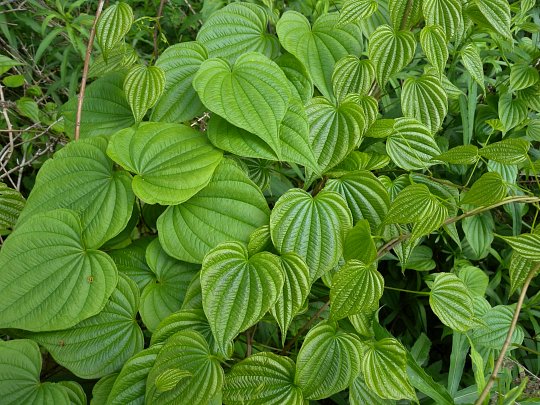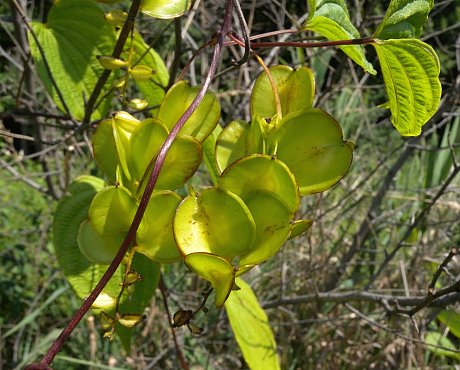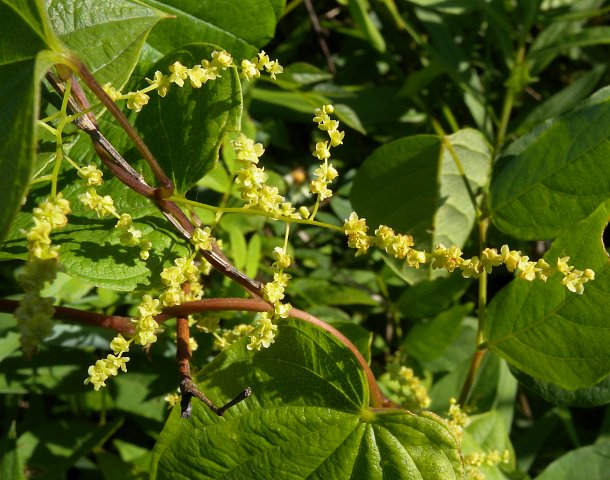
Wild Yam is dioecious, producing vines with either all male flowers or all female flowers. On male vines, panicles of numerous male flowers about 4-12" long develop from the leaf axils. Male flowers are arranged in small clusters of 1-3 along the branches of each panicle. Individual male flowers are about 1/8" (3 mm.) across, consisting of 6 whitish green or yellowish green tepals and 6 fertile stamens. On female vines, racemes of 5-15 female flowers about 3-9" long develop from the leaf axils. Individual female flowers are about 1/8" (3 mm.) across and 1/3" (8 mm.) long, consisting of 6 whitish green or yellowish green tepals and a large inferior ovary with 6 infertile stamens. The blooming period occurs during early summer. The female flowers are replaced by 3-celled seed capsules that are ovoid in shape and about 1" long; these capsules are strongly 3-angled and become golden green as they mature. Each cell of the capsule usually contains 2 seeds (less often, only 1). The flattened seeds have broad membranous wings; they are distributed by the wind. The root system is rhizomatous.

Cultivation: The preference is partial to full sun, moist to mesic conditions, and soil consisting of loam or sandy loam. This vine can survive in light shade, but it is less likely to produce flowers and seed capsules. There are very few problems with insects and disease organisms.
Range & Habitat: The native Wild Yam is occasional to locally common in Illinois; it is found in every county (see Distribution Map). Habitats include thinly wooded bluffs, typical savannas and sandy savannas, woodland borders, typical thickets and sandy thickets, moist sand prairies, powerline and railroad clearances in wooded areas, and fence rows. Wild Yam is found in both high quality and degraded habitats; it benefits from occasional wildfires and other kinds of disturbance that reduce competition from overhead canopy trees.
Faunal Associations: There is very little information about floral-faunal relationships for this species. An insect species, Thrips crawfordi, is sometimes found on the leaves (Nakahara, 1994). The foliage appears to be avoided as a food source by mammalian herbivores. Dense tangles of this vine can enhance nesting habitat for birds and provide cover for various animals.

Photographic Location: The photograph of leaf blades was taken along a fence row in Vermilion County, Illinois, while the photographs of the seed capsules and flowers were taken in moist sandy thickets of the Indiana Dunes National Lakeshore in NW Indiana.
Comments: Like the somewhat similar Greenbriers and Carrion Flowers (Smilax spp.), Wild Yam is a monocot, rather than a dicot. This vine is related to the tropical Yam that is found in grocery stores, but it does not produce edible tubers. Wild Yam can be readily distinguished from similar vines by the palmate venation of its leaves, its racemes or panicles of tiny flowers, and its conspicuous 3-angled seed capsules. In southern Illinois, there is the very similar Dioscorea quaternata (Whorled Wild Yam), which tends to have more whorled leaves than the common Wild Yam that is described here. There is disagreement among authorities regarding the taxonomic status of Whorled Wild Yam: While some authorities regard it as a distinct species (e.g., Mohlenbrock, 2003), other authorities consider it to be merely a variety of Wild Yam, and still others think it is unworthy of any taxonomic recognition.